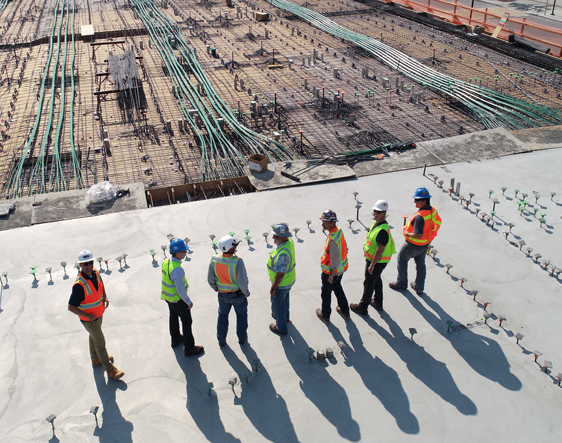There are different attitudes to health and safety around the world, with some countries more stringent in the enforcement of best practice than others. “In New Zealand, there’s a greater cultural appetite for risk than there is in the UK; but there’s also a greater cultural appetite for innovation.” It’s this tendency for innovation that is fuelling a rapid evolution in health and safety terms, says Jon Harper-Slade, who holds four NEBOSH qualifications including both environmental and national Diplomas.
Jon is General Manager of Skills and Competency for Construction Health and Safety NZ Trust (CHASNZ). In the space of just five years, New Zealand has seen not only the development and enactment of a new overarching piece of health and safety legislation, but also the creation of a new regulator. “We’re well disposed to innovation,” notes Jon. “We’re a relatively small population – 4.7 million people – in a country with a large amount of space. New Zealand has always been a test bed for new ideas.”
As is so often the case, the momentum for change in New Zealand – both politically and socially – was born out of a major disaster. In 2010, 29 men were killed in a methane explosion at the Pike River Mine near Greymouth on the South Island’s west coast. “It really was a national tragedy,” says Jon, “and it had a profound effect on New Zealand.”
An inquiry into the disaster led to the establishment of a Royal Commission in 2012 to look at workplace health and safety. The Commission identified some major problems, and in 2013 an independent taskforce was formed. It found there was a need for a new, effective regulator, and in 2013 WorkSafe NZ was established. One of its tasks was to review the health and safety legal framework, which dated back to 1992, and just two years later the Health and Safety at Work Act 2015 was passed, coming into effect in April 2016. The swiftness of the legal and regulatory response to Pike River Mine reflects the shockwaves the tragedy triggered, says Jon: “People knew there was work to do.”
The 2015 Act has created a system similar to that established by the UK’s 1974 Act of the same name: New Zealand’s 2015 legislation is goal setting; has broad coverage; establishes a general duty for employers to look after people’s health, safety and welfare, and manage the risks they create; and places duties on workers to take reasonable care and to follow instructions. But the New Zealand Act goes further by giving officers of businesses (those with decision-making autonomy) specific, personal responsibilities – and liability – for carrying out due diligence, and these duties go further than Section 37 of the UK Act. “It means that if you sit on the board, you are responsible and liable for checking that the organisation is meeting its duties,” Jon explains.
Since the introduction of the Act, various sets of regulations have been produced which tackle specific areas in greater detail. These have included regulations on mining and quarrying, asbestos and adventure activities. One set of regulations currently receiving a great deal of attention concerns worker engagement, representation and participation.
“Worker enagement is a big deal at the moment,” confirms Jon. “It’s not yet five years since I moved to New Zealand, but I really get the sense there’s been a shift change in approach. Our fatality and major injury rates are poor in comparison to Australia and the UK. But the focus is on improving quickly to be where a developed country should be in terms of lag indicators.”
In 2014, the Health and Safety Association of New Zealand (HASANZ) was established to act as an umbrella organisation representing different health and safety professions, with the aim of encouraging collaboration and cooperation between related disciplines. An association of associations, HASANZ represents health and safety practitioners, human factors professionals and ergonomists, among others, and promotes professional competence. “HASANZ helps avoid a silo mentality among the different institutions, and last year it launched a scholarship scheme to bring people into the professions it represents,” explains Jon. WorkSafe, the regulator, and the government have also supported the formation of leadership bodies for the highest-risk industries, including the construction leadership body Jon works for, CHASNZ.
WorkSafe recently appointed Dan Hummerdal – a proponent of the Safety II and Safety Differently approaches to improving health and safety performance – as Chief Advisor on Health and Safety Innovation. Safety II and Safety Differently move the focus from straightforward compliance to a people- and success-led approach which doesn’t view workers as the problem or a barrier to good performance, but as the key.
As in the UK, there’s a push in New Zealand to get employers thinking more about health, both physical – e.g. airborne risks in construction – and mental, with the current focus very much on mental wellness and stress management in the context of New Zealand’s “hard-working, long-hours culture”.
For the future, Jon would like to see health and safety interwoven through everything an organisation does. “What I see sometimes is health and safety filed away with a middle-management leadership role, or limited to a business support function, when really it should be a collaborative effort across all functions.
“We need to put people at the centre and see them as the solution rather than the problem, by focusing on competence and creating a workforce of expertise. To do this we need HR support to recruit and develop leaders who understand these priorities.
“We also need more capable ‘coalface leaders’. The longest-serving worker isn’t necessarily the best choice to be foreman or supervisor. It’s about capability profiling: asking what a procurement person, or an operational supervisor, needs to know about health and safety, because health and safety can’t operate effectively in a silo.”









